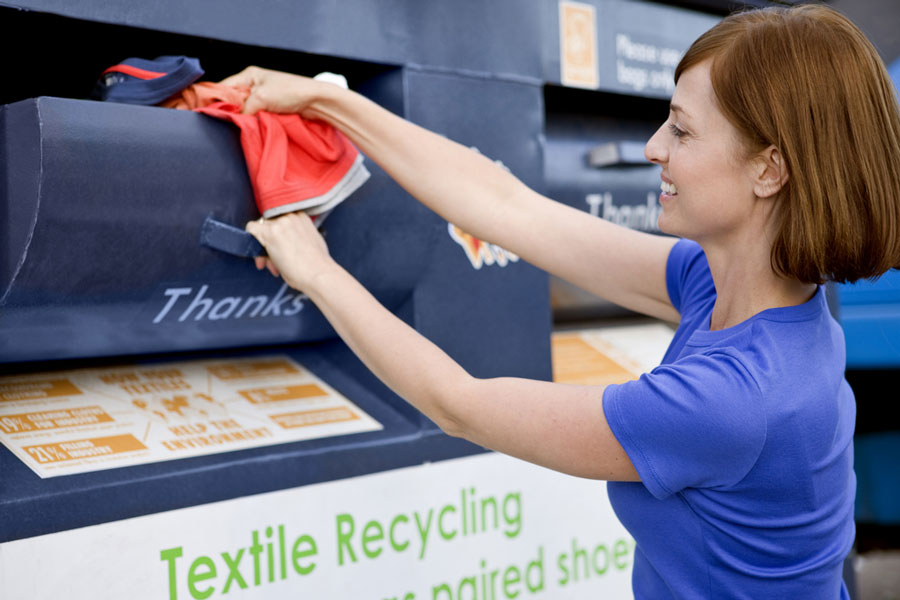Shutterstock
Guest post by Rebecca Beech and Dr. Helen Roby, Centre for Business in Society
Whenever you shop for clothes you notice the rapid churn in clothing ranges available at very low prices – a trend in clothing retailing known as ‘fast fashion’. Fast fashion is defined as being low-cost clothing that is designed to mimic luxury clothing, manufactured on a fast-response system and encourages disposability (Joy et al. 2012, Fletcher 2008). The fast turnaround time of a mere few weeks of clothing being designed, produced and transported, is prominent across many high-street clothing stores e.g. H&M and Zara, with the benefit of heightened profits (Tokatli 2008).
Due to the rapid cycle of clothing production alongside the disposability of fast fashion, this has resulted in huge negative environmental impacts. Here are but a few environmental impacts of fast fashion (Huffington Post 2016, The Guardian 2016):
- Manufacturing of non-natural fibres from petrochemicals, release nitrous oxide which is a greenhouse gas, which is 310 times more damaging than carbon dioxide
- The annual waste, water, and carbon footprint of new and existing clothing in the UK home, equates to 100 pairs of jeans. Which is 1000 bathtubs of water, and emissions released from driving a car for 6000 miles
- One cotton shirt uses 2,700 litres of water to make, which equates to one person’s drinking water for 2 and a half years
- 700,000 micro-plastics are released every time you wash one single man-made garment
The ‘fast fashion’ problem is having serious impacts on the environment, these impacts do not align with new ‘green’ development strategies and policies introduced by the United Nations Environment Programme (UNEP), under the current policy ‘The Green Economy’ (Gibbs and O’Neil 2016). As ‘The Green Economy’ pushes for “low carbon, resource efficient, and socially inclusive [where] growth in income and employment should be driven by public and private investments that reduce carbon emissions and pollution, enhance energy and resource efficiency, and prevent the loss of biodiversity and ecosystem services” (UNEP 2011, 16). Thus, it is vital that ‘fast fashion’ brands step up and make their manufacturing greener, develop effective communication strategies which changes consumers perception about their clothing being ‘disposal’, alongside changing consumer mind-sets of demanding new trends every three weeks.
In the meanwhile, here are a few tips to reduce your impact on the environment when it comes to clothing:
- Stop buying fast fashion! – alternatively shop in charity shops, second hand, or swap clothes with your friends and family
- Instead of throwing your garment away, ask yourself can you mend it? Sew up the hole or take it to a tailor to be fixed or be made to fit
- If you have to throw it away – recycle your clothes at various recycling points in your town/city or give to charity shops
- To increase the longevity of your clothes, wash your clothes less. Also, use less detergent and cold water to further reduce the impact on the environment.
Research by PhD candidate Rebecca Beech, has found that consumers are discussing alternative ways to shop, care and dispose of their clothing, within Twitter. In particular within sub-communities which have similar interests. However, their motivations for changing their shopping/caring/disposal practices of clothing are not necessarily to reduce their environmental footprint. The research further sheds light upon anti-consumerism within online communities, which is magnified via the significant rise of consumer empowerment online. The research aims to explore consumers’ motivations to share knowledge about ‘green’ clothing, alternative shopping methods, and the inter-relationship between knowledge sharing, motivations and consumer empowerment.
If you found this blog post interesting and have interests in my research area, please follow the links to my research profile *https://www.coventry.ac.uk/research/research-directories/researchers/rebecca-beech/* and follow me on LinkedIn *https://www.linkedin.com/in/rebecca-beech-3b165359/* and Twitter *RebeccaBeechCU*. Thank you for reading!
References
Barnes, L. and G. Lea Greenwood (2006) Fast Fashioning the Supply Chain: Shaping the Research Agenda. Journal of Fashion Marketing and Management 10(3), 259-71.
Fletcher, K (2008) Sustainable Fashion & Textiles: Design Journeys. Oxford: Earthscan.
Gibbs, D. O’Neil, K. (2016) Future green economies and regional development: a research agenda. Regional studies, 51(1), 161-173.
Huffington Post (2016) The Environmental Impact of Clothing [online] available from < https://www.huffingtonpost.co.uk/sam-williams1/the-environmental-impact-_1_b_13546078.html?guccounter=1 > [28/06/2018]
Joy, A., Sherry, J. F., Alladi Venkatesh, J., Wang, J., Chan, R. (2012) Fast Fashion, Sustainability, and the Ethical Appeal of Luxury Brands. Fashion Theory Volume 16, (3), 273–296.
Tokatli, N. and O. Kizilgun (2009) From Manufacturing Garments for Ready to Wear to Designing Collections: Evidence from Turkey. Environment and Planning 41, 146-62.
The Guardian (2016) Single clothes wash may release 700,000 microplastic fibres, study finds [online] available from < https://www.theguardian.com/science/2016/sep/27/washing-clothes-releases-water-polluting-fibres-study-finds> [28/06/2018]
United Nations Environment Programme (UNEP). (2011). Towards a green economy: Pathways to sustainable development and poverty eradication – A synthesis for policy makers. [online] available from| <unep.org/greeneconomy/> [28/06/2018]





Comments are disabled